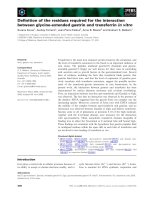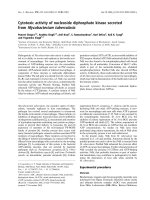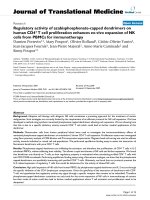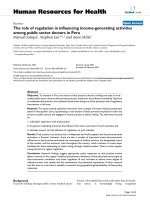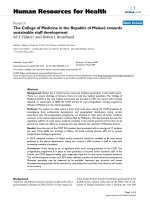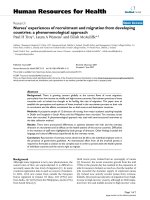Báo cáo sinh học: " Polymerase activity of hybrid ribonucleoprotein complexes generated from reassortment between 2009 pandemic H1N1 and seasonal H3N2 influenza A viruses" ppt
Bạn đang xem bản rút gọn của tài liệu. Xem và tải ngay bản đầy đủ của tài liệu tại đây (316.04 KB, 15 trang )
This Provisional PDF corresponds to the article as it appeared upon acceptance. Fully formatted
PDF and full text (HTML) versions will be made available soon.
Polymerase activity of hybrid ribonucleoprotein complexes generated from
reassortment between 2009 pandemic H1N1 and seasonal H3N2 influenza A
viruses
Virology Journal 2011, 8:528 doi:10.1186/1743-422X-8-528
Wai Yip Lam ()
Karry L K Ngai ()
Paul K S Chan ()
ISSN 1743-422X
Article type Research
Submission date 31 August 2011
Acceptance date 12 December 2011
Publication date 12 December 2011
Article URL />This peer-reviewed article was published immediately upon acceptance. It can be downloaded,
printed and distributed freely for any purposes (see copyright notice below).
Articles in Virology Journal are listed in PubMed and archived at PubMed Central.
For information about publishing your research in Virology Journal or any BioMed Central journal, go
to
/>For information about other BioMed Central publications go to
/>Virology Journal
© 2011 Lam et al. ; licensee BioMed Central Ltd.
This is an open access article distributed under the terms of the Creative Commons Attribution License ( />which permits unrestricted use, distribution, and reproduction in any medium, provided the original work is properly cited.
Polymerase activity of hybrid ribonucleoprotein
complexes generated from reassortment
between 2009 pandemic H1N1 and seasonal
H3N2 influenza A viruses
ArticleCategory :
Research Article
ArticleHistory :
Received: 31-Aug-2011; Accepted: 01-Dec-2011
ArticleCopyright
:
© 2011 Lam et al; licensee BioMed Central Ltd. This is an Open Access
article distributed under the terms of the Creative Commons Attribution
License ( which permits
unrestricted use, distribution, and reproduction in any medium, provided
the original work is properly cited.
Wai Y Lam,
Aff1
Email:
Karry L K Ngai,
Aff1
Email:
Paul K S Chan,
Aff1 Aff2 Aff3
Corresponding Affiliation: Aff3
Phone: +852-2632-3333
Fax: +852-2647-3227
Email:
Aff1
Department of Microbiology, The Chinese University of Hong Kong,
Shatin, New Territories, Hong Kong Special Administration Region,
People’s Republic of China
Aff2
Stanley Ho Centre for Emerging Infectious Diseases, The Chinese
University of Hong Kong, Shatin, New Territories, Hong Kong Special
Administration Region, People’s Republic of China
Aff3
Department of Microbiology, Prince of Wales Hospital, 1/F Clinical
Sciences Building, Shatin, New Territories, Hong Kong Special
Administrative Region, People’s Republic of China
Abstract
Background
A novel influenza virus (2009 pdmH1N1) was identified in early 2009 and progressed to a
pandemic in mid-2009. This study compared the polymerase activity of recombinant viral
ribonucleoprotein (vRNP) complexes derived from 2009 pdmH1N1 and the co-circulating
seasonal H3N2, and their possible reassortants.
Results
The 2009 pdmH1N1 vRNP showed a lower level of polymerase activity at 33°C compared to
37°C, a property remenisence of avian viruses. The 2009 pdmH1N1 vRNP was found to be more
cold-sensitive than the WSN or H3N2 vRNP. Substituion of 2009 pdmH1N1 vRNP with H3N2-
derived-subunits, and vice versa, still retained a substantial level of polymerase activity, which is
probably compartable with survival. When the 2009 pdmH1N1 vRNP was substituted with
H3N2 PA, a significant increase in activity was observed; whereas when H3N2 vRNP was
substituted with 2009 pdmH1N1 PA, a significant decrease in activity occurred. Although, the
polymerase basic protein 2 (PB2) of 2009 pdmH1N1 was originated from an avian virus,
substitution of this subunit with H3N2 PB2 did not change its polymerase activity in human
cells.
Conclusions
In conclusion, our data suggest that hybrid vRNPs resulted from reassortment between 2009
pdmH1N1 and H3N2 viruses could still retain a substantial level of polymerase activity.
Substituion of the subunit PA confers the most prominent effect on polymerase activity. Further
studies to explore the determinants for polymerase activity of influenza viruses in associate with
other factors that limit host specificity are warrant.
Keywords
Human swine influenza, Pandemic, Seasonal, PB1, PB2, PA, NP, RNP, RNA polymerase,
Pathogenesis
Background
In April 2009, the Centers for Disease Control and Prevention (CDC) at Atlanta reported that a
new influenza virus was found in Mexico and the United States [1]. The new influenza A H1N1
virus was soon characterized [2,3] to be a triple reassortant derived from human, avian and swine
influenza viruses [3-5]. The virus spread rapidly worldwide [6] and the World Health
Organization (WHO) declared that the pandemic has reached phase 6 on June 11 2009 [7].
Currently, the virus is still circulating worldwide [7].
Influenza viruses exhibit a restricted host range with limited replication in other species [8-10].
However, on rare occasions, influenza viruses can cross species barrier and adapt to a new host
giving rise to a new lineage. Adaptation to a new species is believed to require multiple point
mutations or reassortment of gene segments, or both. The molecular mechanism and genetic
determinants that restrict, or permit, the replication of influenza viruses in humans remain
unclear. While host haemagglutinin receptor specificity is clearly an important factor, it is not an
absolute barrier to cross-species infection [11-13]. Growing evidence suggests that viral
polymerase and nucleoprotein (NP) play a pivotal role in determining host selection and
adaptation [13,14].
Replication and transcription of influenza RNA segments are regulated by a virus-encoded RNA-
dependent RNA polymerase [14]. The polymerase is a heterotrimeric, multifunctional complex
composed of three viral proteins, polymerase basic protein 1 (PB1), polymerase basic protein 2
(PB2), polymerase acidic protein (PA), which together with the viral NP form the viral
ribonucleoprotein (vRNP) complex that is required for viral mRNA synthesis and replication
[14]. PA is an endonuclease [15-19], and involves in promoter and cap binding [20,21]. PB1
contains active sites for nucleotide elongation [22,23] and binding to promoters of vRNA and
cRNA [22,24,25]. PB2 involves in cap-snatching from host mRNA [26,27], and has been the
focus of host adaptation and pathogenicity study. PB2 mutation, particularly the E627K, has
been linked to the adaption of avian viruses to mammalian host [28,29]. Another PB2 mutation,
D701N, has been associated with increased virulence in mice [30,31].
Given the current co-circulation of the 2009 pandemic H1N1 and seasonal H3N2 viruses, co-
infection of these viruses in humans may occur [32]. In this study, the polymerase activity of
recombinant vRNP complexes that may be created from the reassortment between these two
viruses was examined.
Results
Polymerase activity of pdmH1N1, H3N2 and WSN H1N1 vRNP complexes
The results of luciferase assays performed with the parental 2009 pdmH1N1, H3N2, and WSN
H1N1 vRNPs are shown in Figures 1 and 2. All recombinant vRNPs showed polymerase activity
in both A549 and 293T cells under 33°C or 37°C incubation. A significantly lower level of
polymerase activity for the 2009 pdmH1N1 vRNP was observed at 33°C compared to 37°C for
both cells (293T cells RLU ratio: 0.030 vs 0.298, P = 0.03; A549 cells RLU ratio: 0.050 vs
0.371, P = 0.01) (Figure 1), whereas no significant differences with respect to incubation
temperature were observed for WSN and H3N2 vRNPs (Figure 2).
The polymerase activity of 2009 pdmH1N1 vRNP as recorded from 293T cells incubated at
37°C was significantly lower than that of WSN H1N1 (RLU ratio: 0.498 vs 0.612, P = 0.01), and
this observation was reproduced in A549 cells (RLU ratio: 0.402 vs 0.533, P = 0.01).
Furthermore, in A549 cells, the polymerase activity of 2009 pdmH1N1 vRNP was significantly
lower than that of H3N2 at 33°C (RLU ratio: 0.358 vs 0.396, P = 0.04) and at 37°C (RLU ratio:
0.402 vs 0.479, P = 0.01), respectively (Figure 2).
Polymerase activity of reassortant vRNPs derived from 2009 pdmH1N1 and
H3N2
Figure 3 shows that the results of luciferase assays obtained from hybrid vRNPs derived from
substituting the 2009 pdmH1N1 vRNP with one H3N2 subunit at a time. It was found that
substitution with either H3N2 PB1 or H3N2 PB2 resulted in a slightly decrease in polymerase
activity, whereas substitution with either H3N2 PA or H3N2 NP resulted in an increase in
polymerase activity. The same trend of change in polymerase activity was observed in both 293T
and A549 cells. When subjected to statistical analysis, only the substitution with H3N2 PA
showed a significant increase in polymerase activity of the 2009 pdmH1N1 vRNP in 293T cells
(RLU ratio: 0.34 vs 0.43, P = 0.03).
The results of reciprocal substitution of H3N2 vRNP with 2009 pdmH1N1 subunit are shown in
Figure 4. All hybrid vRNPs with either PB1, PB2, PA or NP derived from 2009 pdmH1N1
showed a decrease in polymerase activity. A statistically significant decrease in polymerase
activity was observed for the substitution with 2009 pdmH1N1 PA in 293T cells (RLU ratio:
0.57 vs 0.43, P = 0.02).
Discussion
Viral polymerase has a key function in the virus replication cycle and likely to play a role in host
adaptation. Previous studies on polymerase activity of influenza were mainly conducted on 293T
cells [33]. The results of this study showed that in addition to 293T cells, A549 cells can also
serve this purpose. Furthermore, A549 cells could be more appropriate as they are derived from
human lung epithelial cells, which is the primary site of replication of influenza viruses.
Our results showed that the polymerase activity of 2009 pdmH1N1 vRNP was significantly
lower than WSN H1N1 and H3N2. The difference in activity was more obvious in A549 cells.
Although, one could not infer on the transmissibility in humans based on polymerase activity
alone, the implication of these in-vitro observations deserves further exploration.
It has been reported that avian influenza viruses are adapted for growth in the avian enteric tract
with higher temperature (37°C), whereas human influenza viruses are adapted for growth at
upper respiratory tract with lower temperature (33°C). It has also been suggested that zoonotic
transmission may be limited by temperature differences between the two hosts [3]. In this regard,
we compared the polymerase activities of the recombinant vRNPs at 33°C and 37°C. The results
showed that the 2009 pdmH1N1 vRNP had a significantly lower activity at 33°C compared to
37°C. It would worthwhile to further investigate whether this was attributed to the avian origin
of the PB2 and PA segments of 2009 pdmH1N1 virus.
In addition to the avian-origin PB2 and PA, the vRNP of 2009 pdmH1N1 virus is composed of a
human-origin PB1 and a classic swine-origin NP. We hypothesized that substitution of one of
these vRNP subunits with a human (H3N2)-origin subunit could confer a change in polymerase
activity. The results of our vRNP subunit substitution experiment showed that each of the 2009
pdmH1N1 vRNP subunit could be substituted by a corresponding H3N2 subunit, and the hybrid
vRNPs still retained a polymerase activity comparable (~ +/− 20%) to the parent vRNP. Among
these substitutions, an H3N2-origin PA conferred a statistically significant increase in the level
of polymerase activity in 293T cells. In reciprocal, a hybrid recombinant H3N2 vRNP
substituted with 2009 pdmH1N1 PA subunit showed a significant decrease in polymerase
activity in 293T cells. The increase in the level of polymerase activity in 293T cells was more
significant than that in A549 cells. Since PA forms a dimer with PB1, the increase in activity
observed in our study might due to a better compatibility of H3N2 PA with 2009 pdmH1N1 PB1
and vice versa. Our observations are in line with a previous study on H5N1, H1N1 and H3N2
subtype viruses, where PA was found to be a major determining factor responsible for the
enhanced polymerase activity of H5N1, while the other subunits had little effect [34,35].
Since the 2009 pdmH1N1 PB2 was originated from an avian subtype lacking the human
adaptation mutation E627K [12,36-40], one might expect that the PB2 subunit of H3N2 could
increase the polymerase activity of 2009 pdmH1N1 vRNP. As yet, when the 2009 pdmH1N1
vRNP was substituted with a human (H3N2) PB2, a slightly decrease in polymerase active was
observed in both 293T and A549 cells. Nevertheless, one should note that the subunits of vRNP
are known to interact with each other. For instance, PB2 interacts with PB1 [41-43] and possibly
with PA [44]. Substituting the 2009 pdmH1N1 vRNP with a PB2 of H3N2 origin may affect
these interactions.
Conclusions
Overall, our data suggest that hybrid vRNPs resulted from reassortment between 2009 pdmH1N1
and H3N2 viruses could still retain a substantial level of polymerase activity. Substituion of the
subunit PA confers the most prominent effect on polymerase activity. Further studies to explore
the determinants for polymerase activity of influenza viruses in associate with other factors that
limit host specificity are warrant.
Methods
In-vitro cell models
Two human cell lines of different tissue origin were used as an in-vitro model to examine the
polymerase activity of vRNP complexes. The A549 cells were derived from human alveolar
basal epithelial adenocarcinoma (ATCC, CCL-185, Rockville, MD, USA), and the 293T cells
were derived from human embryonic kidney (ATCC, CRL-11268). These cells were maintained
in minimum essential medium (MEM) supplemented with 10% fetal bovine serum (FBS), 1%
penicillin, and 1% streptomycin (all from Gibco, Life Technology, Rockville, Md., USA) at
33°C or 37°C in a 5% CO
2
incubator.
Virus strains
Three influenza strains were used for preparing cDNA clones correspond to the respective vRNP
subunits. The A/Auckland/1/2009 (H1N1) represented the 2009 pandemic H1N1 virus (2009
pdmH1N1), the A/HongKong/CUHK-22910/2004 (H3N2) represented seasonal H3N2 virus, and
the A/WSN/1933 (H1N1) (WSN H1N1) was also included as a reference.
Expression of recombinant vRNPs
The PB1, PB2, PA and NP-expressing plasmids of WSN H1N1 were kindly provided by Prof.
George Brownlee [20,34]. The full-length sequences of PB1, PB2, PA and NP of 2009
pdmH1N1 and H3N2 were amplified using Superscript III reverse transcriptase (Invitrogen,
Carlsbad, CA) and PCR with Fusion polymerase (Stratagene, La Jolla, CA, USA). PB1, PA and
NP PCR products were inserted into pcDNA3A plasmids [33] using KpnI and NotI restriction
sites, whereas the HindIII and NotI restriction sites were used for PB2 PCR product. The DNA
sequences of the cloned genes were checked by direct sequencing.
The expression plasmids were used to generate recombinant vRNPs as described previously [45].
Briefly, 1 µg of each plasmid was transfected into 293T or A549 cells by Lipofectamine 2000
(Invitrogen) according to the manufacturer’s instructions. The medium of transfected cells was
replaced by MEM with 10% FBS, 1% penicillin and 1% streptomycin (all from Gibco, Life
Technology) at 6 h post-transfection.
Luciferase reporter assay for viral polymerase activities
A series of different combinations of PB2, PB1, PA and NP protein expression plasmids and the
pPolI-NP-Luc were co-transfected into 293T or A549 cells. In addition, a reporter plasmid
pGL4.73[hRluc/SV40], encoding a Renilla luciferase gene, was co-transfected to serve as a
control for normalizing the transfection efficiency between experiments. At 48 h post-
transfection, the polymerase activities of recombinant vRNPs were determined. According to the
manufacturer’s instructions, cells were lysed by using the Steady-Glo assay reagent (Promega,
Madison, WI, USA) for 10 min and the luminescence was measured by a microplate
luminometer (Wallac VICTOR3, PerkinElmer, Norwalk, CT).
Data analysis
All data were generated from three separate experiments. The results of the luciferase reporter
assay were recorded as relative light units (RLU). The ratio of RLU normalized with the internal
control were used for comparing the polymerase activities between different vRNPs. Differences
in normalized RLU ratio between two vRNPs were compared by the Student’st-test. P-values
less than 0.05 were regarded as significant.
Abbreviations
CDC, Centers for disease control and prevention; cDNA, Complementary deoxyribonucleic acid;
cRNA, Complementary ribonucleic acid; D701N, A change of amino acid 701 from aspartic acid
to asparagine; E627K, A change of amino acid 627 from glutamic acid to lysine; FBS, Fetal
bovine serum; MEM, Minimum essential medium; mRNA, Messenger ribonucleic acid; NP,
Nucleoprotein; PA, Polymerase acidic protein; PB1, Polymerase basic protein 1; PB2,
Polymerase basic protein 2; RLU, Relative light units; vRNA, Viral ribonucleic acid; vRNP,
Viral ribonucleoprotein; WHO, World health organization; 2009 pdmH1N1, 2009 pandemic
H1N1 virus; H3N2, A/HongKong/CUHK-22910/2004; WSN H1N1, A/WSN/1933 (H1N1).
Competing interests
The authors declare that they have no competing interests.
Authors’ contributions
KLKN performed the virus culture, cloning of vRNP plasmids, luciferase reporter assays,
recombinant vRNP assays. WYL was responsible for experimental design, analyses and drafting
of the manuscript. PKSC was responsible for design and supervision of the study. All authors
read and approved the final manuscript.
Acknowledgements
The H1N1— A/WSN/1933 vRNP expression plasmids were kindly provide by Prof. George
Brownlee (Sir William Dunn School of Pathology, University of Oxford). The pandemic H1N1
viral RNA (A/Auckland/1/2009) was kindly provided by Ian G Barr, World Health Organization
Collaborating Centre for Reference and Research on Influenza, Australia. The study was
supported by the Research Fund for the Control of Infectious Diseases, Food and Health Bureau
of the Hong Kong Special Administrative Region Government.
References
1. Centers for Disease Control and Prevention (CDC) 2009a: Update: novel influenza A
(H1N1) virus infection—Mexico March-May, 2009. MMWR Morb Mortal Wkly Rep, 58:585–
589.
2. Itoh Y, Shinya K, Kiso M, Watanabe T, Sakoda Y, Hatta M, Muramoto Y, Tamura D, Sakai-
Tagawa Y, Noda T et al.: In vitro and in vivo characterization of new swine-origin H1N1
influenza viruses. Nature 2009, 460:1021–1025.
3. Kashiwagi T, Hara K, Nakazono Y, Hamada N, Watanabe H: Artificial hybrids of influenza
A virus RNA polymerase reveal PA subunit modulates its thermal sensitivity. PLoS One
2010, 5:e15140.
4. Dawood FS, Jain S, Finelli L, Shaw MW, Lindstrom S, Garten RJ, Gubareva LV, Xu X,
Bridges CB, Uyeki TM: Emergence of a novel swine-origin influenza A (H1N1) virus in
humans. N Engl J Med 2009, 360:2605–2615.
5. Peiris JS, Poon LL, Guan Y: Emergence of a novel swine-origin influenza A virus (S-OIV)
H1N1 virus in humans. J Clin Virol 2009, 45:169–173.
6. Centers for Disease Control and Prevention (CDC) 2009b: Update: novel influenza A
(H1N1) virus infections—orldwide, May 6, 2009. MMWR Morb Mortal Wkly Rep, 58:453–
458.
7. World Health Organization (WHO) 2010. Pandemic (H1N1) 2009:
[http://wwwwhoint/csr/disease/swineflu/en/indexhtml]
8. Beare AS, Webster RG: Replication of avian influenza viruses in humans. Arch Virol 1991,
119:37–42.
9. Hatta M, Halfmann P, Wells K, Kawaoka Y: Human influenza a viral genes responsible for
the restriction of its replication in duck intestine. Virology 2002, 295:250–255.
10. Murphy BR, Sly DL, Tierney EL, Hosier NT, Massicot JG, London WT, Chanock RM,
Webster RG, Hinshaw VS: Reassortant virus derived from avian and human influenza A
viruses is attenuated and immunogenic in monkeys. Science 1982, 218:1330–1332.
11. Abdel-Ghafar AN, Chotpitayasunondh T, Gao Z, Hayden FG, Nguyen DH, de Jong MD,
Naghdaliyev A, Peiris JS, Shindo N, Soeroso S et al.: Update on avian influenza A (H5N1)
virus infection in humans. N Engl J Med 2008, 358:261–273.
12. Hatta M, Gao P, Halfmann P, Kawaoka Y: Molecular basis for high virulence of Hong
Kong H5N1 influenza A viruses. Science 2001, 293:1840–1842.
13. Leung BW, Chen H, Brownlee GG: Correlation between polymerase activity and
pathogenicity in two duck H5N1 influenza viruses suggests that the polymerase contributes
to pathogenicity. Virology 2010, 401:96–106.
14. Palese P, Shaw ML: Orthomyxoviridae: the viruses and their replication, In: Fields
Virology. 5th edition. Edited by Knipe DM, Howley RM. Philadelphia, PA: Lippincott Williams
& Wilkins; pp. 1647–1689.
15. Dias A, Bouvier D, Crepin T, McCarthy AA, Hart DJ, Baudin F, Cusack S, Ruigrok RW:
The cap-snatching endonuclease of influenza virus polymerase resides in the PA subunit.
Nature 2009, 458:914–918.
16. Hara K, Shiota M, Kido H, Ohtsu Y, Kashiwagi T, Iwahashi J, Hamada N, Mizoue K,
Tsumura N, Kato H et al.: Influenza virus RNA polymerase PA subunit is a novel serine
protease with Ser624 at the active site. Genes Cells 2001, 6:87–97.
17. Hara K, Schmidt FI, Crow M, Brownlee GG: Amino acid residues in the N-terminal
region of the PA subunit of influenza A virus RNA polymerase play a critical role in
protein stability, endonuclease activity, cap binding, and virion RNA promoter binding. J
Virol 2006, 80:7789–7798.
18. Obayashi E, Yoshida H, Kawai F, Shibayama N, Kawaguchi A, Nagata K, Tame JR, Park
SY: The structural basis for an essential subunit interaction in influenza virus RNA
polymerase. Nature 2008, 454:1127–1131.
19. Yuan P, Bartlam M, Lou Z, Chen S, Zhou J, He X, Lv Z, Ge R, Li X, Deng T et al.: Crystal
structure of an avian influenza polymerase PA(N) reveals an endonuclease active site.
Nature 2009, 458:909–913.
20. Fodor E, Crow M, Mingay LJ, Deng T, Sharps J, Fechter P, Brownlee GG: A single amino
acid mutation in the PA subunit of the influenza virus RNA polymerase inhibits
endonucleolytic cleavage of capped RNAs. J Virol 2002, 76:8989–9001.
21. Maier HJ, Kashiwagi T, Hara K, Brownlee GG: Differential role of the influenza A virus
polymerase PA subunit for vRNA and cRNA promoter binding. Virology 2008, 370:194–
204.
22. Li ML, Ramirez BC, Krug RM: RNA-dependent activation of primer RNA production by
influenza virus polymerase: different regions of the same protein subunit constitute the two
required RNA-binding sites. EMBO J 1998, 17:5844–5852.
23. Li ML, Rao P, Krug RM: The active sites of the influenza cap-dependent endonuclease
are on different polymerase subunits. EMBO J 2001, 20:2078–2086.
24. Gonzalez S, Ortin J: Distinct regions of influenza virus PB1 polymerase subunit
recognize vRNA and cRNA templates. EMBO J 1999, 18:3767–3775.
25. Jung TE, Brownlee GG: A new promoter-binding site in the PB1 subunit of the influenza
A virus polymerase. J Gen Virol 2006, 87:679–688.
26. Fechter P, Mingay L, Sharps J, Chambers A, Fodor E, Brownlee GG: Two aromatic
residues in the PB2 subunit of influenza A RNA polymerase are crucial for cap binding. J
Biol Chem 2003, 278:20381–20388.
27. Guilligay D, Tarendeau F, Resa-Infante P, Coloma R, Crepin T, Sehr P, Lewis J, Ruigrok
RW, Ortin J, Hart DJ et al.: The structural basis for cap binding by influenza virus
polymerase subunit PB2. Nat Struct Mol Biol 2008, 15:500–506.
28. Labadie K, Dos Santos AE, Rameix-Welti MA, van der WS, Naffakh N: Host-range
determinants on the PB2 protein of influenza A viruses control the interaction between the
viral polymerase and nucleoprotein in human cells. Virology 2007, 362:271–282.
29. Subbarao EK, London W, Murphy BR: A single amino acid in the PB2 gene of influenza A
virus is a determinant of host range. J Virol 1993, 67:1761–1764.
30. Gabriel G, Dauber B, Wolff T, Planz O, Klenk HD, Stech J: The viral polymerase mediates
adaptation of an avian influenza virus to a mammalian host. Proc Natl Acad Sci U S A 2005,
102:18590–18595.
31. Li Z, Chen H, Jiao P, Deng G, Tian G, Li Y, Hoffmann E, Webster RG, Matsuoka Y, Yu K:
Molecular basis of replication of duck H5N1 influenza viruses in a mammalian mouse
model. J Virol 2005, 79:12058–12064.
32. Lee N, Chan PK, Lam WY, Szeto CC, Hui DS: Co-infection with pandemic H1N1 and
seasonal H3N2 influenza viruses. Ann Intern Med 2010, 152:618–619.
33. Brownlee GG, Sharps JL: The RNA polymerase of influenza a virus is stabilized by
interaction with its viral RNA promoter. J Virol 2002, 76:7103–7113.
34. Kashiwagi T, Leung BW, Deng T, Chen H, Brownlee GG: The N-terminal region of the
PA subunit of the RNA polymerase of influenza A/HongKong/156/97 (H5N1) influences
promoter binding. PLoS One 2009, 4:e5473.
35. Song MS, Pascua PN, Lee JH, Baek YH, Park KJ, Kwon HI, Park SJ, Kim CJ, Kim H,
Webby RJ et al.: Virulence and Genetic Compatibility of Polymerase Reassortant Viruses
Derived from the Pandemic (H1N1) 2009 Influenza Virus and Circulating Influenza A
Viruses. J Virol 2011, 85:6275–6286.
36. Le QM, Sakai-Tagawa Y, Ozawa M, Ito M, Kawaoka Y: Selection of H5N1 influenza virus
PB2 during replication in humans. J Virol 2009, 83:5278–5281.
37. Manzoor R, Sakoda Y, Nomura N, Tsuda Y, Ozaki H, Okamatsu M, Kida H: PB2 protein of
a highly pathogenic avian influenza virus strain A/chicken/Yamaguchi/7/2004 (H5N1)
determines its replication potential in pigs. J Virol 2009, 83:1572–1578.
38. Mase M, Tanimura N, Imada T, Okamatsu M, Tsukamoto K, Yamaguchi S: Recent H5N1
avian influenza A virus increases rapidly in virulence to mice after a single passage in mice.
J Gen Virol 2006, 87:3655–3659.
39. Steel J, Lowen AC, Mubareka S, Palese P: Transmission of influenza virus in a
mammalian host is increased by PB2 amino acids 627 K or 627E/701 N. PLoS Pathog 2009,
5:e1000252.
40. Subbarao K, Klimov A, Katz J, Regnery H, Lim W, Hall H, Perdue M, Swayne D, Bender C,
Huang J et al.: Characterization of an avian influenza A (H5N1) virus isolated from a child
with a fatal respiratory illness. Science 1998, 279:393–396.
41. Gonzalez S, Zurcher T, Ortin J: Identification of two separate domains in the influenza
virus PB1 protein involved in the interaction with the PB2 and PA subunits: a model for
the viral RNA polymerase structure. Nucleic Acids Res 1996, 24:4456–4463.
42. Ohtsu Y, Honda Y, Sakata Y, Kato H, Toyoda T: Fine mapping of the subunit binding
sites of influenza virus RNA polymerase. Microbiol Immunol 2002, 46:167–175.
43. Sugiyama K, Obayashi E, Kawaguchi A, Suzuki Y, Tame JR, Nagata K, Park SY:
Structural insight into the essential PB1-PB2 subunit contact of the influenza virus RNA
polymerase. EMBO J 2009, 28:1803–1811.
44. Hemerka JN, Wang D, Weng Y, Lu W, Kaushik RS, Jin J, Harmon AF, Li F: Detection and
characterization of influenza A virus PA-PB2 interaction through a bimolecular
fluorescence complementation assay. J Virol 2009, 83:3944–3955.
45. Fodor E, Devenish L, Engelhardt OG, Palese P, Brownlee GG, Garcia-Sastre A: Rescue of
influenza A virus from recombinant DNA. J Virol 1999, 73:9679–9682.
Figure 1 Polyermase activity of vRNP complexes of 2009 pandemic H1N1 at 33°C and 37°C.
(a) 293T cells, 37°C and 33°C. (B) A549 cells, 37°C and 37°C. Polymerase activity as reflected
by the normalized relative light units ratio (mean ± standard deviation, n = 3) at 37°C compared
to 33°C, * represents statistical significance at p < 0.03, and # represents statistical significance
at p < 0.01
Figure 2 Polyermase activity of vRNP complexes of 2009 pandemic H1N1, seasonal H3N2 and
WSN H1N1. (a) 293T cells, 37°C. (b) 293T cells, 33°C. (c) A549 cells, 37°C. (d) A549 cells,
33°C. Polymerase activity as reflected by the normalized relative light units was expressed as
relative activity (mean ± standard deviation, n = 3) compared to the reference strain WSN H1N1,
* represents statistical significance at p < 0.01 compared to WSN H1N1, and # represents
statistical significance at p < 0.05 compared to H3N2
Figure 3 Polymerase activity of 2009 pdmH1N1 vRNP substituted with H3N2 PB1, PB2, PA
and NP. Recombinant vRNPs were transfected into (a) 293T and (b) A549 cells at an incubation
temperature of 37°C. Polymerase activity as reflected by the normalized relative light units was
expressed as relative activity (mean ± standard deviation, n = 3) compared to the parent
pdmH1N1 vRNP, * represents statistical significance at p < 0.05
Figure 4 Polymerase activity of H3N2 vRNPs substituted with 2009 pdmH1N1 PB1, PB2, PA
and NP. Recombinant vRNPs were transfected into (a) 293T and (b) A549 cells at an incubation
temperature of 37°C. Polymerase activity as reflected by the normalized relative light units was
expressed as relative activity (mean ± standard deviation, n = 3) compared to the parent H3N2
vRNP, * represents statistical significance at p < 0.05
Figure 1
Figure 2
Figure 3
Figure 4
